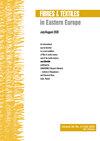Fabric Attractiveness Using Four Sensory Evaluators
IF 0.9
4区 工程技术
Q3 MATERIALS SCIENCE, TEXTILES
引用次数: 0
Abstract
Abstract All senses elicit emotional responses to goods, services, and the environment. They also play an important role in the process of fashion design and its evaluation. This research is a continuation of several preliminary studies we conducted online to define three attractive and three unattractive colors, textures, smells, sounds, and tastes. In the present study, a sample of textile engineering and fashion design students and experts (N = 54) assessed four groups of 6 fabric samples (sensory evaluators) selected based on the results of the preliminary studies. Each group of fabrics was assessed in one of four sensory modalities (except taste). Two semantic differentials were used to assess each sensory modality: attractive/unattractive and boring/interesting in the case of color, insensitive/sensitive in the case of texture, disturbing/calming in the case of sound, and cheap/luxurious in the case of smell. We found that among the fabrics in six different colors, the pink fabric was the most attractive. Of the six textures presented, the knitted rib texture was found to be the most attractive to touch. The scent of lemon essential oil was perceived as the most attractive among the six scents used, and the friction sound of suede leather was perceived as the most attractive among the six friction sounds of fabrics. Cluster analysis showed that the attractiveness of scents and colors of six fabric samples was highly differentiated and (almost) each sample was perceived as unique, while the attractiveness of the texture and sound of different samples was less differentiated and the samples were divided into only two groups. This suggests that discrimination of fabric attractiveness may be better in some sensory evaluators/modalities than in others. The results of this study will be useful for further research on the integration of different sensory modalities in fabric perception and garment preferences.用四种感官评价器评价织物吸引力
所有的感官都会引起对商品、服务和环境的情感反应。他们在服装设计的过程和评价中也起着重要的作用。这项研究是我们在网上进行的几项初步研究的延续,我们定义了三种吸引人的颜色和三种不吸引人的颜色、质地、气味、声音和味道。在本研究中,纺织工程和服装设计专业的学生和专家(N = 54)对基于初步研究结果选择的四组6种织物样品(感官评估者)进行了评估。每组织物在四种感官模式(味觉除外)中的一种进行评估。两种语义差异被用来评估每种感官形态:颜色的吸引力/不吸引力和无聊/有趣,质地的不敏感/敏感,声音的令人不安/平静,气味的廉价/豪华。我们发现在六种不同颜色的面料中,粉红色的面料是最吸引人的。在呈现的六种纹理中,针织罗纹纹理被发现是最吸引人的触觉。柠檬精油的气味被认为是六种气味中最具吸引力的,绒面革的摩擦声被认为是六种织物摩擦声中最具吸引力的。聚类分析表明,6种织物样品的气味和颜色吸引力差异很大,几乎每个样品都被认为是独特的,而不同样品的纹理和声音吸引力差异较小,样品仅分为两组。这表明,某些感官评估者/模式对织物吸引力的辨别可能比其他感官评估者/模式更好。本研究结果将有助于进一步研究不同感官模式在织物感知和服装偏好中的整合。
本文章由计算机程序翻译,如有差异,请以英文原文为准。
求助全文
约1分钟内获得全文
求助全文
来源期刊

Fibres & Textiles in Eastern Europe
工程技术-材料科学:纺织
CiteScore
1.60
自引率
11.10%
发文量
12
审稿时长
13.5 months
期刊介绍:
FIBRES & TEXTILES in Eastern Europe is a peer reviewed bimonthly scientific journal devoted to current problems of fibre, textile and fibrous products’ science as well as general economic problems of textile industry worldwide. The content of the journal is available online as free open access.
FIBRES & TEXTILES in Eastern Europe constitutes a forum for the exchange of information and the establishment of mutual contact for cooperation between scientific centres, as well as between science and industry.
 求助内容:
求助内容: 应助结果提醒方式:
应助结果提醒方式:


